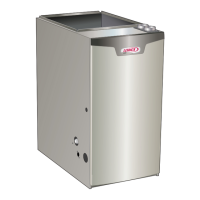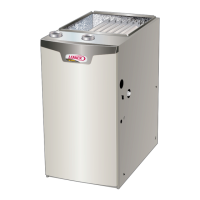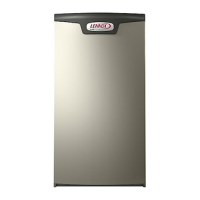Page 9
I-UNIT COMPONENTS
EL297DFV(X) unit components are shown in FIGURE 1.
The gas valve, combustion air inducer and burners can be
accessed by removing the access panel. Electrical com-
ponents are in the control box (FIGURE 2) found in the
blower section.
ELECTROSTATIC DISCHARGE (ESD)
Precautions and Procedures
CAUTION
Electrostatic discharge can aect
electronic components. Take precautions
to neutralize electrostatic charge by
touching your hand and tools to metal
prior to handling the control.
A- Control Box
1. Control Transformer (T1)
A transformer located in the control box provides power
to the low voltage section of the unit. Transformers on all
models are rated 40VA with a 120V primary and a 24V
secondary.
2. Door Interlock Switch (S51)
A door interlock switch rated 14A at 125VAC is wired in se-
ries with line voltage. When the inner blower access panel
is removed the unit will shut down.
Transformer
SureLight
®
Integrated Control
Interlock Switch
Circuit Breaker
FIGURE 2
3. Circuit Breaker (CB8)
A 24V circuit breaker is also located in the control box.
The switch provides overcurrent protection to the trans-
former (T1). The breaker is rated 3A at 32V. If the current
exceeds this limit the breaker will trip and all unit opera-
tion will shutdown. The breaker can be manually reset by
pressing the button on the face. See FIGURE 3.
PRESS TO RESET
FIGURE 3
WARNING
Shock hazard.
Disconnect power before servicing. Integrated
control is not eld repairable. If control is inoperable,
simply replace entire control.
Can cause injury or death. Unsafe operation will
result if repair is attempted.
4. Integrated Control (A92)
Units are equipped with a communicating enabled Sure-
Light
®
two-stage, variable speed integrated control. This
control is used with a communicating thermostat as part
of a communicating comfort system. The control can also
operate with a non-communicating conventional single or
two-stage thermostat. The system consists of a ignition /
blower control (FIGURE 4 and FIGURE 6) with control pin
designations in TABLE 1, TABLE 2, TABLE 3 and ignitor
(FIGURE 14). The control and ignitor work in combination
to ensure furnace ignition and ignitor durability. The con-
trol provides gas ignition, safety checks and indoor blower
control with two-stage gas heating. The furnace combus-
tion air inducer, gas valve and indoor blower are controlled
in response to various system inputs such as thermostat
signal, pressure and limit switch signal and ame signal.
The control features a seven-segment LED display, indi-
cating furnace status (including indoor blower) and error
codes. The LED ashes in single digits. The control also
has two unpowered (dry) 1/4” contacts for a humidier and
a 120 volt accessory terminal. Both rated at (1) one amp
each.
Electronic Ignition
At the beginning of the heat cycle the integrated control
monitors the rst stage and second stage combustion air
inducer prove switch. The control will not begin the heating
cycle if the rst stage prove switch is closed (by-passed).
Likewise the integrated control will not begin the second
stage heating cycle if the second stage prove switch is
closed, and will remain in rst stage heat. However, if the
second stage prove switch closes during the rst stage
heat pre-purge, the control will allow second stage heat.
Once the rst stage prove switch is determined to be open,
the combustion air inducer is energized on low (rst stage)
heat speed. When the dierential in the prove switch is
great enough, the prove switch closes and a 15-second
pre-purge begins.

